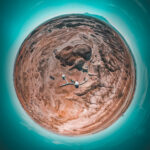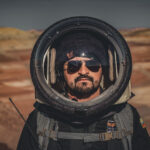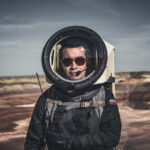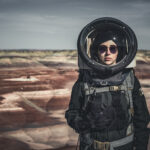Roger Gilbertson – Commander
Donald Jacques – Executive Officer, Crew Engineer
Liz Cole – Health & Safety Officer, Crew Journalist
Guillaume Gégo – Crew Scientist
Scott Beibin – Crew Astronomer, Artist In Residence
Hugo Saugier – Documentary Filmmaker
INTRODUCTION
The six person crew of MDRS 286 came from individual applicants and invited people. We represent a range of cultures, talents, experiences, backgrounds, and varied interests.
We plan to perform a good variety of projects; hard science of bacteria growth helpful for creating closed-loop life support systems, conducting advanced extended range EVA capabilities, technology demonstrations using in situ resources, and various artforms including music performance, videography, photography, and storytelling.
Additionally, we plan to host two visiting photographers and have invited them to remain “in sim” with us as much as physically possible. An educational outreach may be performed via a live link to science museums and/or Mars Society groups in Europe.
OUR PROJECTS
PROJECT 1: CO2 Fixation by Purple Bacteria for Space Food Production: A Comparison of Three Electron Sources & Terrestrial Applications.
Lead: Guillaume Gégo
Background: Master degree in Biochemistry, Molecular and Cellular Biology at UMONS, BE.
Process: The CO2PROT project aims to develop an efficient, sustainable and reliable Bacteriological Life Support System for manned space exploration using purple bacteria.
Purple bacteria are known for their metabolic heterogeneity, which allows for different compounds, like wastes or in situ resources, to be envisaged as substrates.
Among these, carbon dioxide remediation is by far the most attractive option, as it traps waste into potentially edible biomass. With the carbon source defined, multiple electron sources are available, but no comparative data has ever been accumulated to rule out the better option, would it be for space exploration or terrestrial applications.
In this study, three main metabolisms leading to CO2 fixation will be compared by studying the growth of purple bacteria model Rhodospirillum rubrum in:
Photoheterotrophy: High-electron-content volatile fatty acids (Butyrate/Valerate).
Photoautohydrogenotrophy: Hydrogen.
Photoautoelectrotrophy: Electron flux (current).
The bacteria will be grown inside low-cost bag photobioreactors to assess the possibility of mass-production in altered gravity, while reducing costs of terrestrial downfalls of the study. Analog missions are therefore ideal platforms to test if such installations are feasible on other planets. Since photoheterotrophy was already studied in another analog (AATC, Poland), photoautohydrogenotrophy will be tested at MDRS as a follow-up.
Deliverable: Master thesis mission report.
PROJECT 2: Performing Extended Extra-Vehicular Activities Using a Mobile Analog Space Habitat
Lead: Donald Jacques
Background: EVA’s at MDRS are constrained by the range of the rovers, time necessary to recharge the batteries, as well as the physical strain on participating crew members, exposed to the elements during travel, much less being able to replenish food, air, water during an extended EVA.
Process: For our MDRS Mission 286, we wish to include the MASH (Mobile Analog Space Habitat) in the mission simulation, for the purpose of an Extended Excursion EVA. The MASH vehicle is a former school bus converted into a mobile habitat with an integrated Ecological Life Support system including heating, cooling, food and water supply, and waste handling. The habitat and life support are powered by an on board solar array with battery backup, and can operate overnight as a shelter if the need arises. These qualities closely approximate the features that NASA is including in the SEV. Our purpose in incorporating the MASH is to assess and evaluate the Extended Excursion EVA for long duration exploration and science study as an adjunct to the science study of the EVA.
Deliverable: Final report, photos & video.
PROJECT 3: Creating High Resolution Interactive Digital Assets of MDRS and Local Geological Sites Using 3D Scanning techniques.
Lead: Scott Beibin
Background: LiDAR, Photogrammetry, Neural Radance Fields (NeRFs) and other techniques can be used for accurately creating detailed high resolution digital twins that can be utilized for remote study of objects and landscapes. This can include examining equipment that has undergone stresses (rocket motors, fuel tanks, protective shielding) and looking at geological features. The advantage of having high resolution scans is that there can be coordination of examinations between explorers on Mars as well as remote support teams on Earth and elsewhere. Currently I have been using a variety of LiDAR devices for my own archaeological explorations.
Process: This project proposes using multiple scanners and techniques to create digital twins of the equipment at the station as well as the station itself. Local geological features will also be scanned during EVAs.
Deliverable: 3D scans of varying resolutions will be created in order to be used in the MARS VR Project.
PROJECT 4: Producing Functional Artifacts Using Local Clay Resources and a 3D Extrusion Printer
Lead: Scott Beibin
Background: This project proposes collecting local clay and gypsum from the vicinity of MDRS and processing it into 3D printed objects intended for either durability or ecologically minded disposability. I have designed a 3D plotter/printer that will be used for this project (Mandelbot Ecotech SURFA2 Goostruder).
Process: Dry clay and gypsum will be gathered from geotagged local deposits during EVAs. The aggregate materials will be sifted from and examined for their various pozzolan qualities using a microscope as well as other tests. The materials will be reconstituted then printed using a 3D printer specifically designed for printing objects using clay, pastes and colloids.
Deliverable: A variety of 3D printed objects will be created either from digital twin LiDAR scans or creations within CAD software. This will include clay and/or gypsum planters for the Green Hab as well as molds for Project 5.
PROJECT 5: Using Local Gypsum Resources to Produce Molds for Metal Casting
Lead: Roger Gilbertson
Background: Residents of Mars will take advantage of local resources as much as possible. After fulfilling their original purposes, metal components of spaceships and other equipment brought from Earth can be melted and reformed into other useful items. The age-old techniques of mold making and metal casting will find new uses on Mars.
Process: This project proposes collecting local gypsum from the vicinity of MDRS, processing it into plaster (as demonstrated by previous MDRS missions), and using it to make molds for metal casting. The “original” form can be designed and 3D printed at MDRS, then used to make negative molds in plaster. Using low-temperature, non-toxic bismuth metal, we will demonstrate casting of small, complex metal components.
Deliverable: 3D original, plaster molds, metal castings, final assembled metal item, photos and videos.
PROJECT 6: Mars Academy – A Documentary Film About ESA Scientist Claude Chipaux and the Past, Present and Future of Mars Life Sciences
Lead: Hugo Saugier
Background: When my grandfather Claude died in 2010, I discovered that he was the founder of a research program of the European Space Agency, dedicated to the question of the autonomy of the crews of long journeys in space. I then understood that the popular figure of the high-tech astronaut is gradually changing, being replaced by a new kind of galactic explorers: astronaut-farmers. For a while, I didn’t know what to do with such a heritage, until I recently decided to write a movie about Mars dreamers in which my grandfather would be one of the characters.
Process: I will film the crew during its daily life in MDRS and do a sort of a travelog which will be useful for the writing of the movie. I want to collect the reality of each one’s experience. Collective moments, organization of the place, maintenance, etc, will be interesting moments to be filmed. As we’ll be simulating, I may want to add a bit of simulation by fictionalizing some scenes (for example during an EVA, doing an emergency situation). I want to show how we imagine living on Mars is. I will do individual interviews with each that wants, more in the shape of confessionals.
Deliverable: Documentary movie.
PROJECT 7: Simulating Acoustics of Mars for an Outdoor Martian Music Performance
Lead: Scott Beibin
Background: Using recordings from the electret microphone mounted on the Supercam on the Perseverance Rover a ground truth for the modeling of acoustic processes in the environment on Mars was characterized for the first time in the audible range and beyond (20 Hz to 50 kHz). SuperCam’s microphone recorded air pressure fluctuations from 20 Hz to 12.5 kHz or 50 kHz, at sampling rates of 25 kHz or 100 kHz. Recordings of the Ingenuity rotorcraft and laser-induced sparks were used as reference sources of sound.
It was discovered that:
– The acoustic impedance of the martian atmosphere results in approximately 20 dB weaker sounds on Mars than on Earth – if produced by the same source.
– The acoustic attenuation range on Mars was discovered to be roughly between 20Hz to 20kHz.
– Two different speeds of sound were observed on Mars. Low-pitched sounds travel at about 537 mph (240 meters per second), while higher-pitched sounds move at 559 mph (250 meters per second) because of the low-pressure 96 percent CO2-dominated atmosphere (compared to 0.04 percent CO2 on Earth).
– The atmospheric pressure on Mars is about 0.6 kPa (170 times lower than on Earth).
Process: Using the data that was published in Journal Nature [https://www.nature.com/articles/s41586-022-04679-0] and on the Nasa website [https://mars.nasa.gov/mars2020/participate/sounds] I collaborated with audio engineer John Knott to create a filter in a DAW (Digital Audio Workstation) that accurately simulates the way sound travels on Mars.
I composed two Ptelepathetique tracks to be performed on synthesizer at Barrainca Butte while on an EVA. The compositions were made to optimize for the way sound travels on Mars. In addition to the musical compositions, I will be exploring optimal frequency ranges that could be used for safety alerts and alarms for humans operating in a Martian environment.
Deliverable: High quality audio and video recordings of Ptelepathetique tracks will be recorded that compare the way the tracks will sound on Earth and Mars. These will be posted on social media accompanied by a story of the process.
PROJECT 8: Documenting the MDRS Mission 286 Adventure in Words and Images
Lead: Liz Cole
Background: Life in the constraints of the Martian environment requires a shift to more sustainable life support systems such as vegan and plant based food production and building with local resources. Crew 286 of MDRS is developing various technologies to support life on Mars while addressing Earth’s most pressing environmental problems. Documenting the crew conducting their research, EVAs and life throughout the course of the mission will highlight the work of researchers at MDRS.
Process: I will document the research and activities of the crew throughout the mission. I will weave the narrative of each sol in the daily journalist reports, including images and video captured by myself and other crew members. And I will write the final media reports for the mission. I will bring a Sony A7iii camera with standard and telephoto lenses for photo and video. Schedule allowing, I will conduct video interviews with crew members where they tell the story of their work. Post mission, I will compile a longer written piece exploring and explaining the experience of the mission and submit it for publication.
Deliverable: Daily Journalist reports, web postings for Mars Society, images, video.
PROJECT 9: Evaluating Performance of Biological Life Support Components Installed within the Mobile Analog Space Habitat
Lead: Donald Jacques
Background: A Biological Regenerative Life Support System needs to provide not only environmental support for a team, but a variety of food, water processing, and waste processing. The Mobile Analog Space Habitat is equipped with a min-farm containing many species that interact in order to process a circular economy of nutrients, water, wastes, and air.
Process: Measurements of environmental conditions, populations, general health, inputs to and outputs from each species will be recorded during the 14-day mission at intervals of morning, noon, and evening.
Positive results would include egg production from the quail, new fingerlings in the fish tank, measurable growth of the crop species, mealworms, red worms, and measurable output of oxygen from algae tubes.
Deliverable: Final report, photos & video.
ADDITIONAL / OPTIONS
Participation by some crew members in the research study conducted by Andres Käosaar into “teamwork in isolated, confined, and extreme environments.”
Photography of night sky, using time lapse, wide lens, and telescopic imaging.
Videography of Mars-like surface environments and astronaut activities.
Gather notes for design of a Mars-Earth Situational Awareness (MESA) informational website.
Hosting of two guest New York Times photojournalists (for 4 nights).
Possible educational link-up Belgian science center and Mars Society of France.
Thanksgiving on Mars.





















You must be logged in to post a comment.